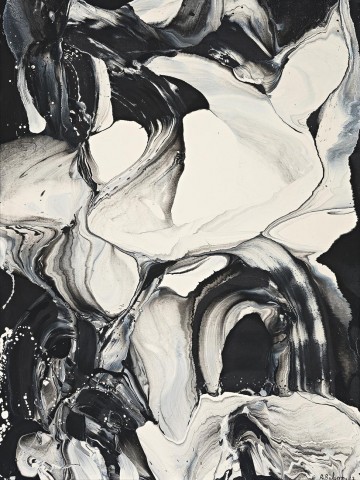MATTER PAINTING, 1962
RALPH BALSON
enamel on composition board
122.0 x 91.5 cm
signed and dated lower right: R. Balson 62
inscribed on old artist’s label verso: No. 13 / …
Macquarie Galleries, Sydney
Private collection
Niagara Galleries, Melbourne (label attached verso)
The Western Mining Corporation, Australia
WMC Collection of Australian Contemporary Art, Sotheby’s, Melbourne, 15 March 2004, lot 110
Private collection, Sydney
Ralph Balson Exhibition of Paintings, Macquarie Galleries, Sydney, 3 – 15 July 1963, cat. 13 (as ‘Painting No. 13’)
Ralph Balson 1890 – 1964, Niagara Galleries, Melbourne, 21 June – 15 July 1989, cat. 10 (illus.)
Ralph Balson’s Matter Paintings were perhaps the most radical of his career. In the early 1960s, Balson completely abandoned the cool geometric formalism of his Constructive paintings, and surrendered aesthetic control to follow a spontaneous and semi-automatic style of gestural painting. Throughout his career, he had tirelessly sought a process of abstract painting that would respect the physical qualities of his material while illustrating what he would call the ‘ineffable’,1 the sublime and invisible forces of the universe. This pursuit led him through a disciplined, logical progression of different styles of pure painting – from planar geometric abstraction, to a painterly fragmentation and finally, the ‘Matter Paintings’ whose appearance was entirely governed by the inherent physical properties of poured paint. In this last major series of his career, the artist’s joy in the pure physicality of gesture and material supported the metaphysical underpinnings of his earlier painterly investigations, producing artworks whose swirling surfaces evoke the primordial tohubohu, the formless chaos of all things in the universe, great and small.
Matter Painting, 1962, is an expansive and organic example of this late style, where opposing forces compete in shallow pictorial space, jet-black enamel seeping into pools of cream paint with marbled frontiers and spattered incursions. In the absence of a clear focal point and the rectilinear format that had hitherto governed Balson’s compositions, the viewer’s eye is free to wander across the surface – a true Greenbergian all-over painting. While newspaper reviews of the time saw parallels with the nascent disciplines of molecular science, as well as space photography,2 the ripples and spatters inherent in Matter paintings can subjectively seem to coalesce into a wide range of organic forms. The ebbs and flows of their state of flux seem to breach the confines of the artist’s own grey wooden frame. Surprisingly, as opposed to using the smooth and varnished face, the artist has used the reverse side of a Masonite sheet for this painting, its tooth providing resistance against the flow of paint and a delicate foundation of texture beneath its veined surface.
Balson was a well-read artist, keenly following the developments of international art theory in books and periodicals. In 1960, he travelled abroad for the first time since emigrating to Australia as a boy, visiting exhibitions of the most progressive painting in Paris, London and New York. The gestural and spontaneous approaches of Tachisme and Art Informel were particularly stimulating for Balson. However, the artist also sought stimuli from beyond the field of visual arts, citing the ‘density and fluidity’ of James Joyce’s Finnegan’s Wake as inspiration for his newfound stream-of-consciousness and surrealist automatism in painting.3 The hypnotic surfaces of the Matter paintings are governed by the physical laws of the medium, following ‘its own rhythm, its own structure – a natural paint structure’4. The painting process became an allegory for Balson’s deep understanding of the physicality of the natural world, the relentlessness of universal flux, and the ultimate inevitability of entropy.
1. Adams, B., ‘Metaphors of Scientific Idealism: The theoretical background to the paintings of Ralph Balson’ in Bradley, A. and Smith, T. (eds), Australian Art and Architecture: Essays presented to Bernard Smith, Oxford University Press, Melbourne, 1980, p. 188
2. Henshaw, J., ‘Spattering and Scattering’, The Bulletin, Sydney, 24 February 1962
3. The artist, 1956, quoted in Gleeson, J., ‘Fluid Forms and Colours’, The Sydney Morning Herald, Sydney, 5 November 1967, p. 108
4. The artist quoted in Thomas, D., ‘Ralph Balson’, Art and Australia, Ure Smith, Sydney, vol. 2, no. 4, 1965, p. 290
LUCIE REEVES-SMITH
